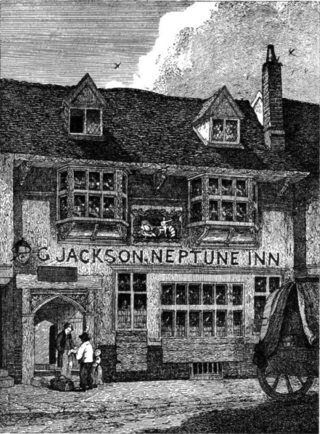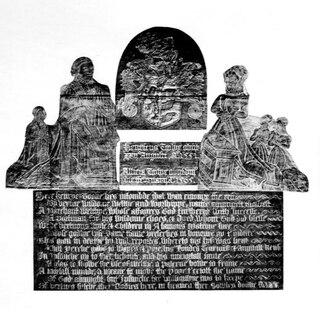
The Ipswich Racecourse is an area of Ipswich in Suffolk, England, that was formerly a racecourse from 1710 to 1911.

Wortham is a village and parish in Suffolk, England, close to the border with Norfolk. Its church, St Mary the Virgin, lies about a mile north of the present-day village. It is one of 38 existing round-tower churches in Suffolk and the one with the greatest diameter in England.

The Ipswich Docks, Ipswich wet dock and the wet dock, are a series of docks in Port of Ipswich located at a bend of the River Orwell which has been used for trade since at least the 8th Century. A wet dock was constructed in 1842 which was 'the biggest enclosed dock in the United Kingdom' at the time. A major regeneration of the area has taken place since 1999.
Tollemache Breweries Ltd. was a brewing company which originated in Ipswich in 1888 and became a major brewer in East Anglia before merging with their rival Cobbold and Co. to form Tolly Cobbold in 1957. The brewery was founded by three sons of John Tollemache, 1st Baron Tollemache - Douglas, Stanhope and Mortimer Tollemache - who bought the Cullingham Brewery in Upper Brooke Street. This had been established as a Steam Brewery in 1856 by Charles Cullingham. Douglas Tollemache was keen to ensure a high quality product.

Neptune Inn is an historic public house located in Fore Street, Ipswich, Suffolk, England. The building was originally built around 1490 and is grade II* listed.

Richard Dykes Alexander was a businessman and philanthropist based in Ipswich, Suffolk.

John Dupuis Cobbold was a member of the Ipswich based Cobbold family.

The Steam Packet Inn was a public house located at 2/4 Duke Street, Ipswich, Suffolk, England. It closed on 18 September 1960. The building had been owned by Cobbold Brewery but after closure it was sold to Eastern Counties Farmers (ECF). The grade II listed building is now used as student accommodation.
Ipswich and Suffolk Freehold Land Society (FLS) was founded in 1849 as part of the "forty-shilling freeholders movement" which developed across England. Its aim was to enable "the ordinary man" to obtain sufficient property to meet the requirements needed to gain the vote. The movement had been started by James Taylor of Birmingham. On Saturday 1 December 1849 the first meeting of the society was advertised in the Suffolk Chronicle. Richard Dykes Alexander, the head of the Alexander banking family, was the first president.
Charles Foote Gower was an English soap manufacturer based in Ipswich. He was a significant businessman in that town.

George Green Sampson (1804-1885) was a physician and politician in Ipswich, Suffolk.

John Speed's Ipswich is a graphic account of the town of Ipswich, Suffolk created by John Speed in conjunction with the Dutch engraver, Jodocus Hondius, in 1610. It was featured as an inset for his map of the county of Suffolk, published in Theatre of The Empire of Great Britaine. It is the earliest extant map of Ipswich and features many buildings of the late medieval period, whilst at the same time showing streets laid out in a grid pattern which has largely been retained into the twenty first century.

Stoke Mill was an historic watermill located in Ipswich, Suffolk. It was located on the north bank of the River Orwell next to Stoke Bridge. It was on Bridge Street where there is now a skate park.
Christ's Hospital, Ipswich was established in Tudor Ipswich, Suffolk. The original benefactors were Richard Felaw, William Smarte and Henry Tooley.

Henry Tooley was a Suffolk, England merchant. Alive during the Tudor period, by the time of his death he was one of the richest businessmen in the town of Ipswich. He was closely associated with the fellow merchant and Member of Parliament for Ipswich, Robert Daundy. His trade network extended Biscayan ports, the Netherlands and Iceland as well as including much of East Anglia east of line drawn between Chelmsford and Thetford – and the highly populated and industry towns of south Suffolk in particular.
Frederick Brett Russell was an English architect and artist based in Ipswich, Suffolk.

King Street, Ipswich is a street in central Ipswich.

St Mildred's Church, Ipswich was a parish church located at The Cornhill, Ipswich. It was dedicated to Saint Mildred, an Abbess of Thanet who died in the eighth century. The church was built shortly after her death, but became used as an administrative centre in the fourteenth century. Only a chapel was retained for religious use until the reformation.
Samuel Belcher Chapman was an English philanthropist who dedicated himself to supporting the St Matthews Industrial Home for Girls in Ipswich, Suffolk. Following a brief period in partnership with Henry Biddell in London, Chapman moved to Ipswich in 1830 and by October 1831, he had received the credentials from Apothecaries' Hall, London to practice as chemist and druggist. He then set up in business first in Tavern Street, moving to Cornhill by 1832.
West End Bathing Place was an outdoor swimming venue in Ipswich, Suffolk.














